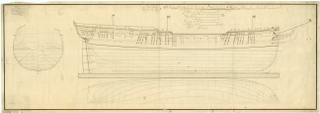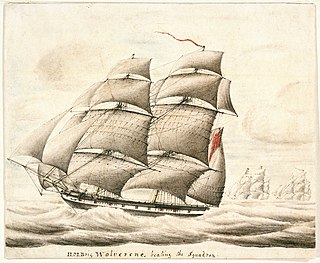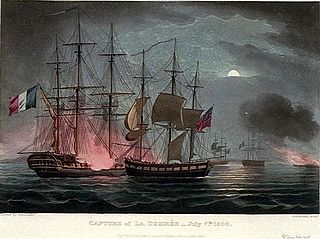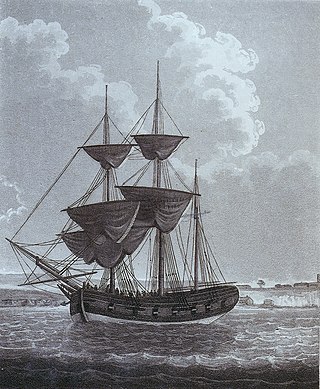HMS Pickle was a topsail schooner of the Royal Navy. She was originally a civilian vessel named Sting, of six guns, that Lord Hugh Seymour purchased to use as a tender on the Jamaica station. Pickle was at the Battle of Trafalgar, and though she was too small to take part in the fighting, Pickle was the first ship to bring the news of Nelson's victory to Great Britain. She also participated in a notable single-ship action when she captured the French privateer Favorite in 1807. Pickle was wrecked in 1808, but without loss of life.
HMS Leda, launched in 1800, was the lead ship of a successful class of forty-seven British Royal Navy 38-gun sailing frigates. Leda's design was based on the French Hébé, which the British had captured in 1782. Leda was wrecked at the mouth of Milford Haven in 1808, Captain Honeyman was exonerated of all blame, as it was a pilot error.

HMS Cerberus was a 32-gun fifth-rate frigate of the Royal Navy. She served in the French Revolutionary and the Napoleonic Wars in the Channel, the Mediterranean, the Adriatic, and even briefly in the Baltic against the Russians. She participated in one boat action that won for her crew a clasp to the Naval General Service Medal (NGSM). She also captured many privateers and merchant vessels. Her biggest battle was the Battle of Lissa, which won for her crew another clasp to the NGSM. She was sold in 1814.

HMS Wolverine was a Royal Navy 18-gun Cruizer-class brig-sloop, launched in 1805 at Topsham, near Exeter. Early in her career she was involved in two fratricidal incidents, one involving a British frigate and then a newsworthy case in which she helped capture a British slave ship. She later captured a small naval vessel and several privateers, and took part in the invasion of Martinique, and during the War of 1812, in the attack on Baltimore. Wolverine was decommissioned in August or September 1815 and was sold on 15 February 1816.

HMS Manly was an Archer-class gun-brig launched in 1804. During her career first the Dutch captured her, then the British recaptured her, then the Danes captured her, and finally the British recaptured her again. The British renamed her HMS Bold after her recapture in 1813. She was sold out of service in 1814.
HMS Bold was a 14-gun Archer-class gun-brig of the Royal Navy built at Blackwall Yard. She took part in several minor actions and captured some prizes before she grounded in 1811 and was broken up shortly thereafter.

The Raid on Dunkirk of 7 July 1800 was an attack by a British Royal Navy force on the well-defended French anchorage of Dunkirk in the English Channel during the French Revolutionary Wars. French naval forces had been blockaded in their harbours during the conflict, and often the only method of attacking them was through fireships or "cutting-out" expeditions, in which boats would carry boarding parties into the harbour at night, seize ships at anchor and bring them out. The attack on Dunkirk was a combination of both of these types of operation, aimed at a powerful French frigate squadron at anchor in Dunkirk harbour. The assault made use of a variety of experimental weaponry, some of which was tested in combat for the first time with mixed success.

HMS Hyacinth was an 18-gun ship-sloop of the Cormorant class in the Royal Navy, launched in 1806 at Great Yarmouth. In 1810 she was reclassed as a 20-gun Post-ship. She was again re-rated as 24 guns in 1817. Hyacinth took part in some notable actions on the coast of Spain, one of which earned qualified in 1817 for the Naval General Service Medal. She was broken up in 1820.
HMS Alcmene was a 32-gun Alcmene-class fifth rate of the Royal Navy. This frigate served during the French Revolutionary and Napoleonic Wars under the command of several notable officers. Alcmene was active in several theatres of the war, spending most of her time cruising in search of enemy vessels or privateers, and escorting convoys. She fought at the Battle of Copenhagen in 1801 and served in the blockade of the French coasts during the later Napoleonic Wars until she was wrecked on the French coast in 1809.

HMS Wolverine, was a Royal Navy 14-gun brig-sloop, formerly the civilian collier Rattler that the Admiralty purchased in 1798 and converted into a brig sloop, but armed experimentally. She served during the French Revolutionary Wars and participated in one action that won for her crew a clasp to the Naval General Service Medal. A French privateer captured and sank Wolverine on 21 March 1804 whilst she was on convoy duty.
HMS Basilisk was a Bloodhound-class gun-brig built by Randall in Rotherhithe and launched in 1801. She served briefly at the end of the French Revolutionary Wars, with most of her service occurring during the Napoleonic Wars protecting convoys from privateers, conducting close-inshore surveillance and taking enemy coastal shipping. She was sold for breaking in 1815.
During the period of the French Revolutionary and Napoleonic Wars, there were two or three vessels known as His Majesty's hired armed cutter Active that served the British Royal Navy. The reason for the uncertainty in the number is that the size of the vessels raises the possibility that the first and second may have been the same vessel.
HMS Nemesis was a 28-gun Enterprise-class sixth-rate frigate of the Royal Navy. The French captured her in 1795 at Smyrna, but in 1796 a squadron led by Barfleur brought her out of the neutral port of Tunis. Throughout her career she served under a number of commanders who would go on to have distinguished careers. She was converted to a troopship in 1812 and was sold in 1814.

HMS Cruizer was a Royal Navy Cruizer-class brig-sloop built by Stephen Teague of Ipswich and launched in 1797. She was the first ship of the class, but there was a gap of 5 years between her launch and the ordering of the next batch in October 1803; by 1815 a total of 105 other vessels had been ordered to her design. She had an eventful wartime career, mostly in the North Sea, English Channel and the Baltic, and captured some 15 privateers and warships, and many merchant vessels. She also participated in several actions. She was laid up in 1813 and the Commissioners of the Navy sold her for breaking in 1819.
HMS Firm was a 12-gun Archer-class gun-brig of the Royal Navy, launched on 2 July 1804. She served in the Channel, where she engaged in one action that would eventually result in her crew qualifying for the Naval General Service Medal. She grounded in 1811 and her crew had to destroy her before abandoning her.
HMS Quebec was a 32-gun fifth-rate frigate launched in 1781 and broken up in 1816. She sailed under various captains, participating in the American Revolutionary War, the French Revolutionary Wars, and the Napoleonic Wars. During these wars she captured many enemy merchantmen and smaller privateers. One action led to her men qualifying for clasp to the Naval General Service Medal.

The Républicaine française was a 32-gun frigate of the French Navy, of the Galathée class. The Royal Navy captured her in 1796. The Navy fitted her as a troopship in 1800, but both as a troopship, and earlier as a frigate, she captured several small Spanish and French privateers. She was broken up in 1810.
At least two vessels known as His Majesty's hired armed lugger Nile served the Royal Navy during the French Revolutionary and Napoleonic Wars. These may have been the same vessel on sequential contracts.

HMS Harpy was a Royal Navy Diligence-class brig-sloop, launched in 1796 and sold in 1817. She was the longest lived vessel of her class, and the most widely travelled. She served in both the battle of Copenhagen and the British invasion of Java, took part in several actions, one of which won for her crew a clasp to the Naval General Service Medal, and captured numerous privateers. The Navy sold her in 1817.
HMS Redbreast was an Archer-class brig of the British Royal Navy. She captured some small merchant vessels and privateers. She also participated in two actions that would in 1847 earn her surviving crew members clasps to the Naval General service Medal (NGSM). The Navy transferred in 1816 to His Majesty's Customs. She was finally sold in 1850.










